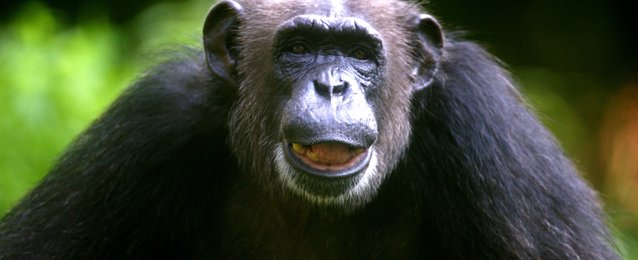Since at least the 1920s, anecdotes and some studies have suggested that chimpanzees are “super strong” compared to humans, implying that their muscle fibers, the cells that make up muscles, are superior to humans.
But now a research team reports that contrary to this belief, chimp muscles’ maximum dynamic force and power output is just about 1.35 times higher than human muscle of similar size, a difference they call “modest” compared with historical, popular accounts of chimp “super strength,” being many times stronger than humans.
Further, says biomechanist Brian Umberger, an expert in musculoskeletal biomechanics in kinesiology at the University of Massachusetts Amherst, the researchers found that this modest performance advantage for chimps was not due to stronger muscle fibers, but rather the different mix of muscle fibers found in chimpanzees compared to humans.
As the authors explain, the long-standing but untested assumption of chimpanzees’ exceptional strength, if true, “would indicate a significant and previously unappreciated evolutionary shift in the force and/or power-producing capabilities of skeletal muscle” in either chimps or humans, whose lines diverged some 7 or 8 million years ago.
Umberger was part of the team led by Matthew O’Neill at the University of Arizona College of Medicine, Phoenix, and others at Stony Brook University, Harvard and Ohio State University. Details of this work, supported in part by a National Science Foundation grant to Umberger, appear in the current early online edition of Proceedings of the National Academy of Sciences.
The researchers began by critically examining the scientific literature, where studies reported a wide range of estimates for how chimpanzees outstrip humans in strength and power, averaged about 1.5 times over all. But Umberger says reaching this value from such disparate reports “required a lot of analysis on our part, accounting for differences between subjects, procedures and so on.” He and colleagues say 1.5 times is considerably less than anecdotal reports of chimps being several-fold stronger, but it is still a meaningful difference and explaining it could advance understanding of early human musculoskeletal evolution.
Umberger adds, “There are nearly 100 years of accounts suggesting that chimpanzees must have intrinsically superior muscle fiber properties compared with humans, yet there had been no direct tests of that idea. Such a difference would be surprising, given what we know about how similar muscle fiber properties are across species of similar body size, such as humans and chimps.”
He explains that muscle fiber comes in two general types, fast-twitch, fast and powerful but fatigue quickly, and slow-twitch, which are slower and less powerful but with good endurance. “We found that within fiber types, chimp and human muscle fibers were actually very similar. However, we also found that chimps have about twice as many fast-twitch fibers as humans,” he notes.
For this work, the team used an approach combining isolated muscle fiber preparations, experiments and computer simulations. They directly measured the maximum isometric force and maximum shortening velocity of skeletal muscle fibers of the common chimpanzee. In general, they found that chimp limb and trunk skeletal muscle fibers are similar to humans and other mammals and “generally consistent with expectations based on body size and scaling.”
Umberger, whose primary scientific contribution was in interpreting how muscle properties will affect whole-animal performance, developed computer simulation models that allowed the researchers to integrate the various data on individual muscle properties and assess their combined effects on performance.
O’Neill, Umberger and colleagues also measured the distribution of muscle fiber types and found it to be quite different in humans and chimps, who also have longer muscle fibers than humans. They combined individual measurements in the computer simulation model of muscle function to better understand what the combined effects of the experimental observations were on whole-muscle performance. When all factors were integrated, chimp muscle produces about 1.35 times more dynamics force and power than human muscle.
Umberger says the advantage for chimps in dynamic strength and power comes from the global characteristics of whole muscles, rather than the intrinsic properties of the cells those muscles are made of. “The flip side is that humans, with a high percentage of slow-twitch fibers, are adapted for endurance, such as long-distance travel, at the expense of dynamic strength and power. When we compared chimps and humans to muscle fiber type data for other species we found that humans are the outlier, suggesting that selection for long distance, over-ground travel may have been important early in the evolution of our musculoskeletal system.”
The authors conclude, “Contrary to some long-standing hypotheses, evolution has not altered the basic force, velocity or power-producing capabilities of skeletal muscle cells to induce the marked differences between chimpanzees and humans in walking, running, climbing and throwing capabilities. This is a significant, but previously untested assumption. Instead, natural selection appears to have altered more global characteristics of muscle tissue, such as muscle fiber type distributions and muscle fiber lengths.”
If our reporting has informed or inspired you, please consider making a donation. Every contribution, no matter the size, empowers us to continue delivering accurate, engaging, and trustworthy science and medical news. Independent journalism requires time, effort, and resources—your support ensures we can keep uncovering the stories that matter most to you.
Join us in making knowledge accessible and impactful. Thank you for standing with us!

